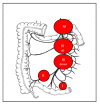Surgery and Perioperative Management in Small Intestinal Neuroendocrine Tumors
- PMID: 32708330
- PMCID: PMC7408509
- DOI: 10.3390/jcm9072319
Surgery and Perioperative Management in Small Intestinal Neuroendocrine Tumors
Abstract
Small-intestinal neuroendocrine tumors (SI-NETs) are the most prevalent small bowel neoplasms with an increasing frequency. In the multimodal management of SI-NETs, surgery plays a key role, either in curative intent, even if R0 resection is feasible in only 20% of patients due to advanced stage at diagnosis, or palliative intent. Surgeons must be informed about the specific surgical management of SI-NETs according to their hormonal secretion, their usual dissemination at the time of diagnosis and the need for bowel-preserving surgery to avoid short bowel syndrome. The aim of this paper is to review the surgical indications and techniques, and perioperative and postoperative management of SI-NETs.
Keywords: carcinoid crisis; carcinoid syndrome; small bowel neuroendocrine tumor; surgery.
Conflict of interest statement
Board AAA, IPSEN, Novartis, Keocyt GC; board Novartis SD.
Figures







References
-
- Le Roux C., Lombard-Bohas C., Delmas C., Dominguez-Tinajero S., Ruszniewski P., Samalin E., Raoul J.-L., Renard P., Baudin E., Robaskiewicz M., et al. Relapse factors for ileal neuroendocrine tumours after curative surgery: A retrospective French multicentre study. Dig. Liver Dis. 2011;43:828–833. doi: 10.1016/j.dld.2011.04.021. - DOI - PubMed
Publication types
LinkOut - more resources
Full Text Sources

